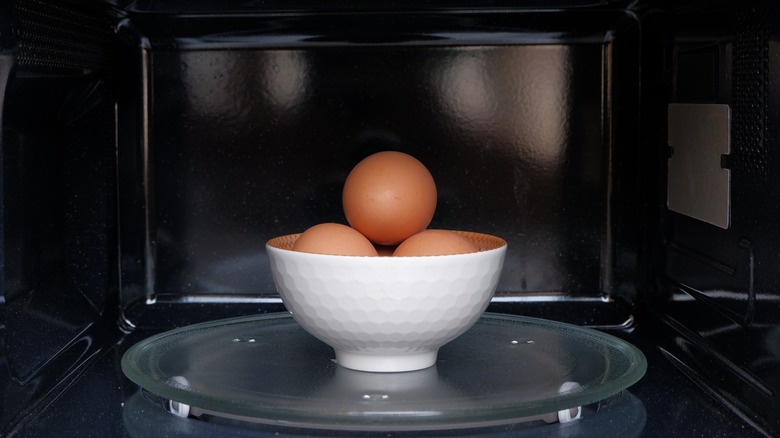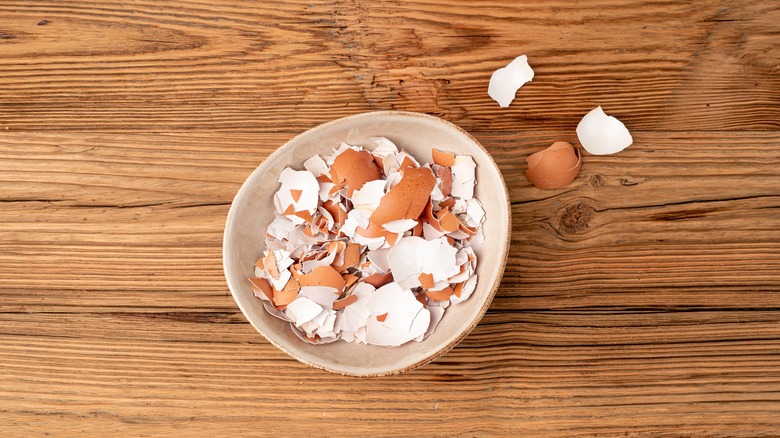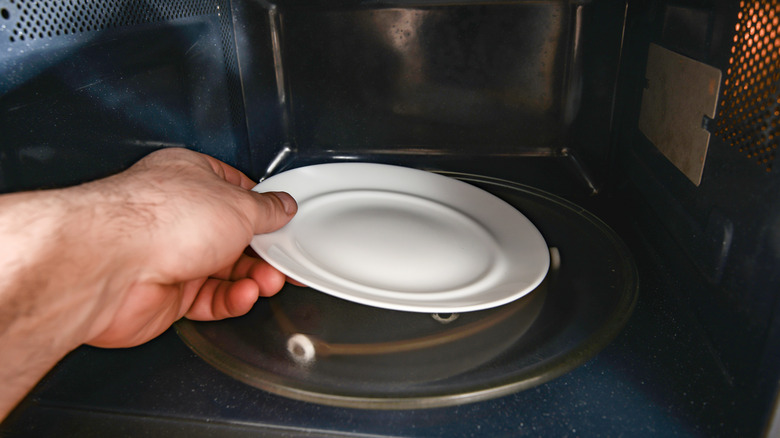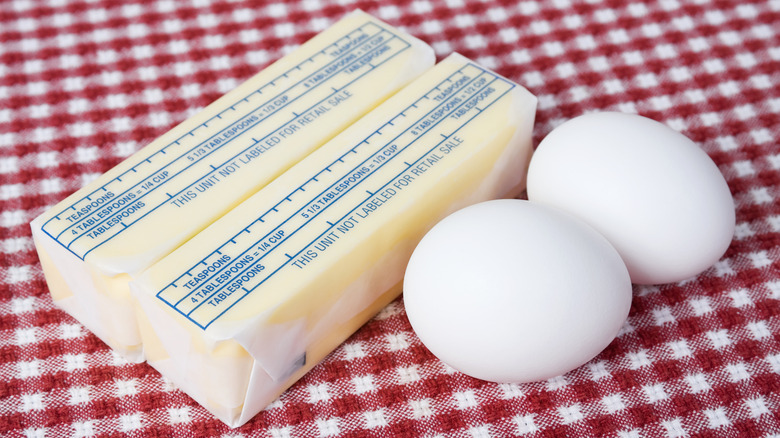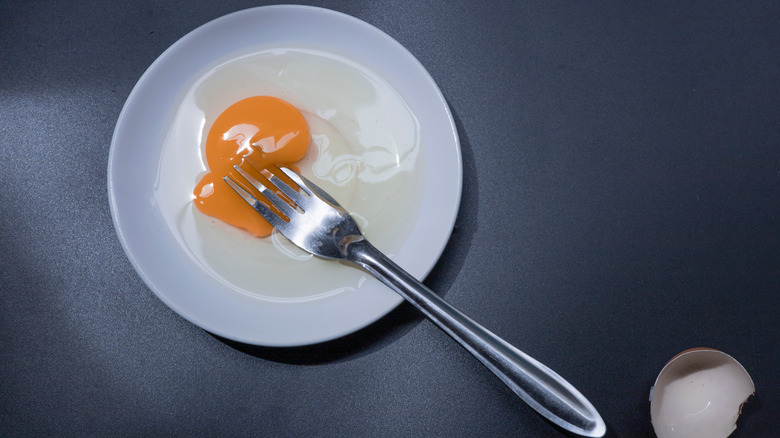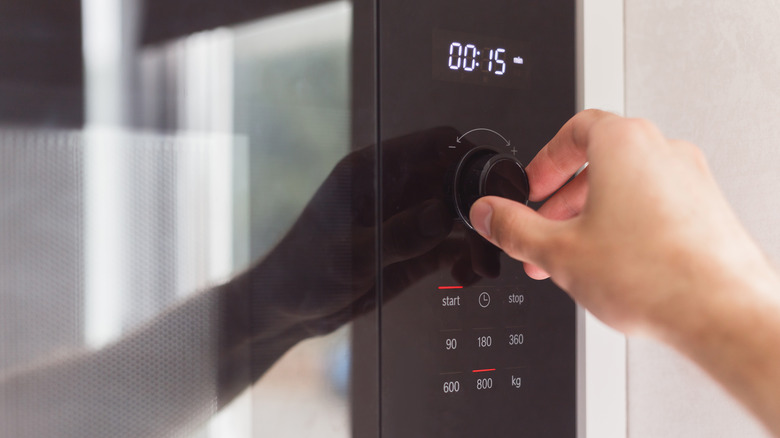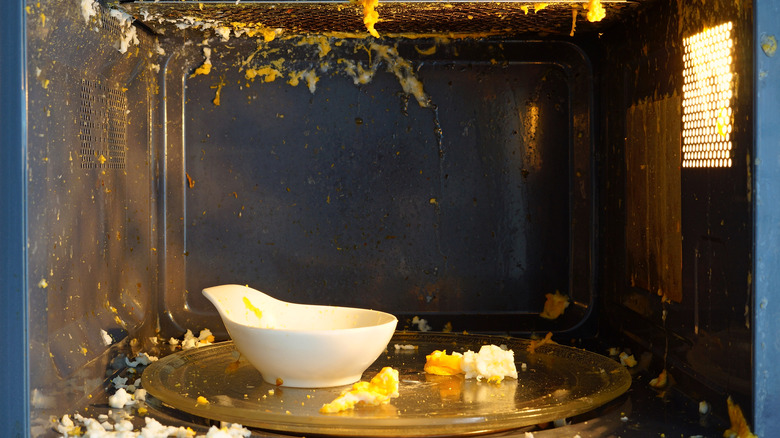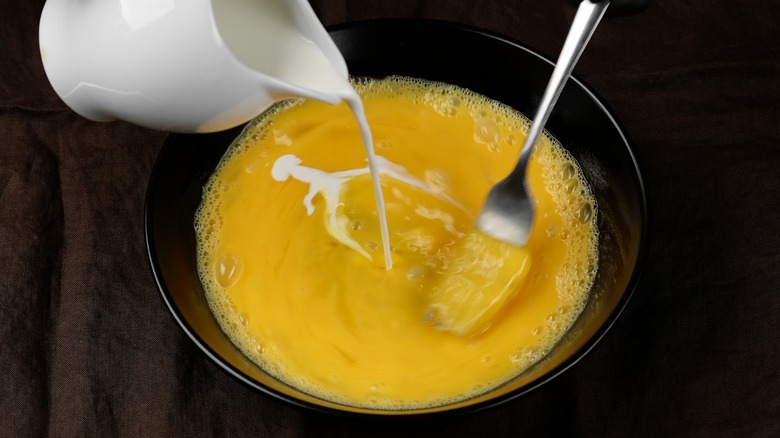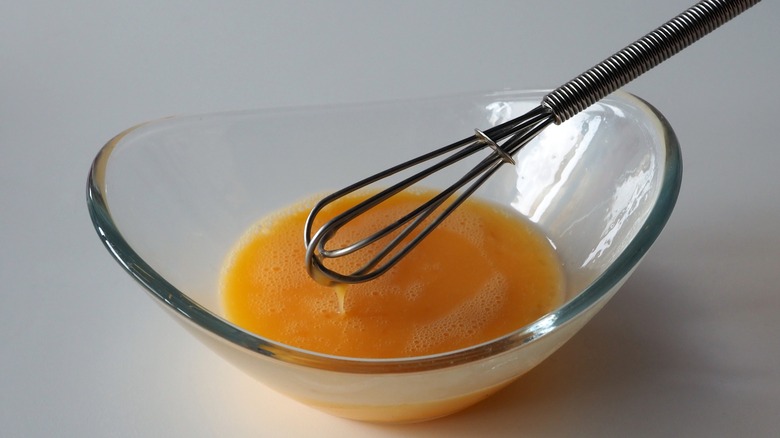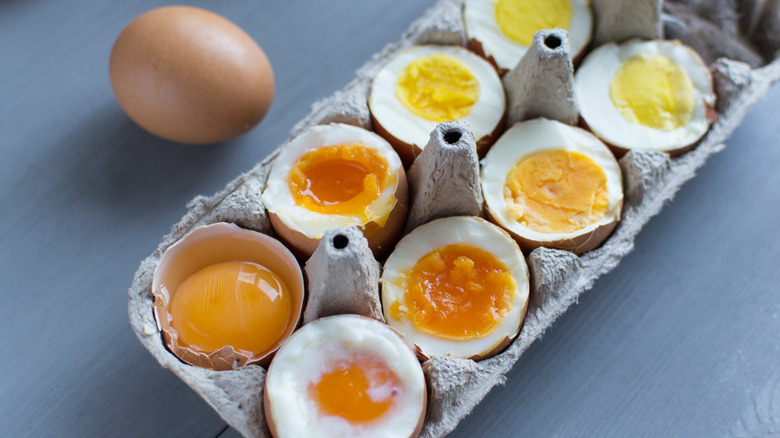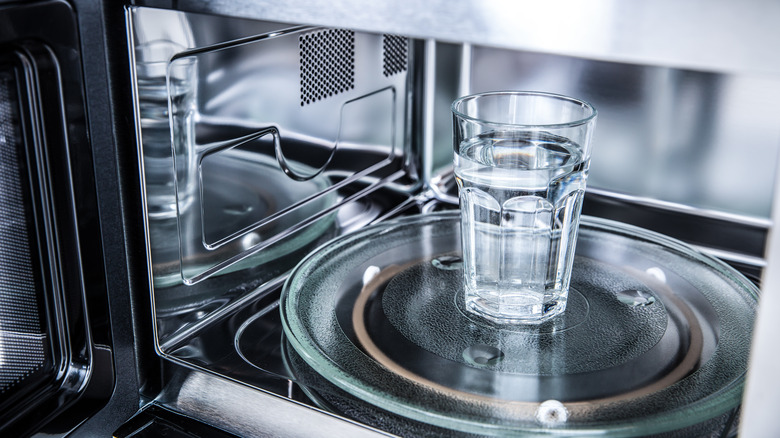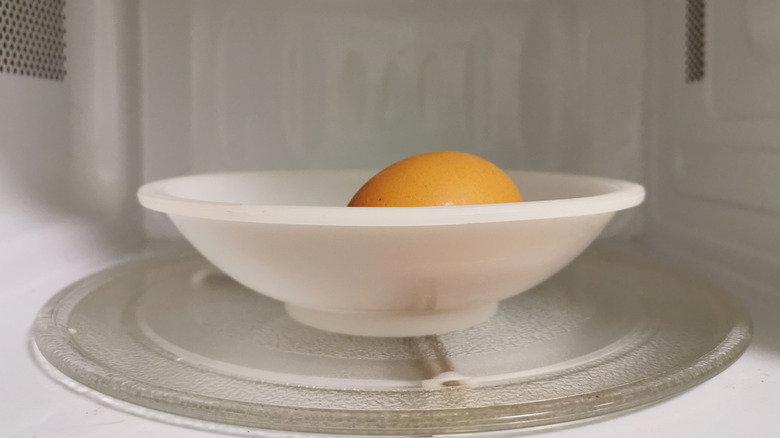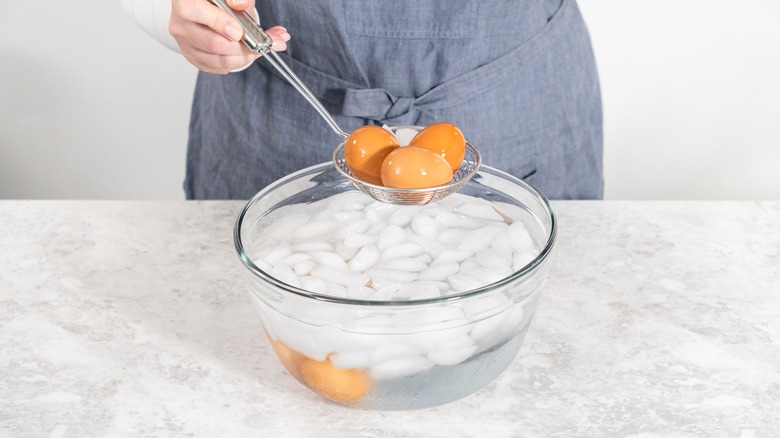Mistakes Everyone Makes When Cooking Eggs In The Microwave
The microwave probably isn't the first cooking method you think of when preparing eggs, but it actually works quite well. However, it can also go wrong if you don't know how to avoid potential mistakes. While not every misstep surrounding microwaved eggs are as dramatic as an explosion, you'll want to steer clear of them all the same.
With a few helpful tips, eggs can be easily soft or hard-boiled, scrambled, poached, and "fried" in the microwave. Best of all, the microwave cooks eggs fast. So, if you only have access to a microwave at your workplace or are simply short on time, learning which mistakes to avoid will come in handy more than you think.
I scoured food blogs, chef recommendations, and more to compile a list of mistakes everyone makes when cooking eggs in the microwave. Keep reading to find out what they are so you never fall prey to these mistakes again. If you can manage to avoid them all — which isn't that difficult — you'll be microwaving eggs like a pro in no time.
Accidentally letting eggshells sneak their way in
No matter what kind of egg you are making or how you are cooking it, allowing fragments of the shell to sneak their way in should be avoided at all costs. Not only are the shells inedible, but as the U.S. Department of Agriculture notes, they also carry bacteria. Plus, who wants to accidentally bite into a cooked egg and find a crunchy shell in their mouth? Luckily, even if you let this mistake happen, it's easy to fix. Just make sure you do before you put the egg in the microwave and start cooking it.
Cracking an egg without any pieces of eggshell breaking off may take a bit of practice. Don't worry if you mess it up, though. You can fish out any small pieces of shell with a fork. Once you get the hang of the standard egg-cracking method (where you use both hands), you may even want to try the one-handed technique. It minimizes the transfer of bacteria to your hands (because you only use one), makes you feel like a real chef, and let's face it, looks pretty cool if you can pull it off.
Not preheating the plate when making a fried egg
You may think cooking a decent fried egg in the microwave is unattainable, but I disagree. If you follow a few key tips and avoid some crucial mistakes, your microwave can actually make a pretty good fried egg. The first mistake you want to stay clear of is forgetting to preheat the plate you cook the egg on. If you do, it's not the end of the world, but it certainly won't do you any favors. Worst case scenario, it'll just be easy to tell it was cooked in the microwave. This is not all bad, but you can do better.
Preheating the plate is as simple as it sounds. Before you do anything else, place a small, empty plate in the microwave for two minutes. Then, proceed like normal. When you start with a warm plate, it creates better-textured whites and helps the yolk and whites cook more evenly. Don't expect to get a nice crispy lace around the edges, but still, you'll have a nicely fried egg all the same.
Leaving butter or oil out of the equation when making a fried egg
The next mistake you want to avoid when microwaving eggs is forgetting to grease the plate you cook a fried egg on. When preparing eggs on the stove, greasing a pan is basically second nature for most of us. Even so, this crucial step is easily overlooked when it comes to cooking in the microwave. Maybe it's because many of us typically use the microwave to reheat foods or maybe it's just being in a hurry. Either way, this small mistake should be avoided.
After pre-heating a small plate, grease it up with a small amount of cooking spray, oil, or butter. The addition of any of these lubricants helps prevent the egg from sticking to the plate. When you opt for butter, it also adds a hint of rich flavor. If you plan to transfer the fried egg after cooking, a bit of grease on the plate makes this possible. If you want to eat the egg on the plate you cook it on, this may not seem like a big deal, but it definitely allows easier manipulation of the egg while you enjoy it. As a result, you can slide it around on the plate to add other ingredients, and the yolk will remain in tact.
Forgetting to pierce the yolk or shell when making a fried or hard-boiled egg
Piercing the shell of a hard-boiled egg is a simple hack that helps ensure you don't wind up with a dreaded egg explosion. Some people advise against making hard-boiled eggs in the microwave because cooking them in their shells increases the risk of it exploding. If this happens, it can cause burns, damage the microwave, and, of course, cause a sticky mess. Even so, you can seriously diminish the chances of an egg explosion by poking a small hole in the shell with a pin. A tiny hole helps relieve pressure within the eggshell. While this trick seriously helps during the initial cooking process, never reheat a hard-boiled egg in the microwave because the chances of catastrophe are nearly unavoidable.
Along those same lines, fried eggs also benefit from a small hole in the yolk before cooking in the microwave. Use a fork, toothpick, or knife to pierce a small hole in the top of the yolk. If you only puncture the top layer, hopefully, the yolk will stay intact and won't leak out immediately. That way, you get the satisfaction of piercing the runny yolk after it is cooked. For many, that's the main appeal of fried eggs. Plus, when the yolk stays mostly intact while in the microwave it results in more even cooking.
Cooking with the power too high
Depending on who you ask, cooking eggs in the microwave at full power can either be no big deal or a huge mistake. Soft-boiled eggs typically do fine when cooked in the microwave on high power. Scrambled eggs don't do bad either. However, poached and fried eggs often benefit from cooking at reduced power levels. For a poached egg, try reducing the power level to 50% or 80% and you may be surprised at how well it turns out. After about one minute — maybe a bit more, depending on the specific microwave and how well done you prefer your eggs — you'll have a beautifully poached egg.
Some recommendations claim that changing your microwave's power level to as low as 30% or 50% for any kind of egg is a good idea because it is more gentle and leads to improved cooking results. It can also help prevent explosions, something we can all get behind. Cooking an egg at a super low power level will result in slightly longer cook times, but it may be worth the wait if it eliminates a potential mess or damage.
Not covering the bowl when poaching or hard-boiling an egg
To hard boil or poach an egg in the microwave you must place it in a bowl of water. While this may seem like common sense to anyone who has poached or hard-boiled an egg on the stove before, it isn't uncommon for people to accidentally forget a lid when using the microwave. But don't be one of those people — always cover the bowl of water with a lid, like a small plate or saucer.
Leaving a lid out of the equation doesn't necessarily lead to an egg's downfall, but it seriously reduces your chances of a proper cook. A cover helps trap heat inside, just like on the stove, resulting in shorter cook times and even results throughout the egg.
In addition to assisting in even, quick cooking, covering the bowl you microwave hard-boiled or poached eggs in helps contain a potential explosion. To avoid that mess, it's smart to use a lid every time.
Not adding oil, milk, or water to a scrambled egg
Similar to making scrambled eggs on the stove, a little bit of liquid goes a long way in the microwave, too. If you're trying to decide between water and milk, just know that water makes the fluffiest scrambled eggs. However, many chefs opt for butter or oil instead. Really, though, the choice is yours and the use of any one of these liquids will result in tasty scrambled eggs.
One tablespoon of water or milk per egg is all you need to whip up microwave scrambled eggs (the same goes for other cooking methods). When it comes to oil or butter a bit less is acceptable, but why would you hold back on butter? It makes everything taste better, scrambled eggs included. After you select the liquid you prefer, whisk it with the eggs in a microwave-safe bowl and you're already most of the way there. A sprinkle of salt and pepper is also recommended, but how you season your scrambled eggs is entirely up to you. No matter what you use, don't make the mistake of leaving out the liquid. If you do, your scrambled eggs won't be nearly as appetizing.
Not stirring scrambled eggs every 30 seconds or so
Regardless of what appliance you use to prepare scrambled eggs, stirring them regularly helps promote better cooking results by evenly distributing the heat throughout and breaking up any lumps before they get a chance to fully form. Stirring also leads to better texture, ensuring they don't become rubbery or overly dry. Lastly, regular stirring allows you to monitor the cooking progress with better accuracy, something that isn't as easy to do when cooking in the microwave. It's not like you can just look into the pan and assess whenever — because you have to actually pull the eggs out of the microwave.
While it varies somewhat depending on who you ask, in general, you should stir microwave scrambled eggs about every 30 seconds. Some cooks recommend stirring every 20 seconds, and others in 45-second intervals, but what's most important is that you are in fact stirring them. You can also use the opportunity to see how close they are to being done to your liking. I recommend starting with 30-second intervals and making minor adjustments to best suit your personal preferences and, of course, your specific microwave. Slightly different cook times are common because microwaves vary greatly from one model to the next.
Cooking for too long
Every microwave is different, so recommended cook times are typically more like an estimate. When it comes to eggs, they are not uniformly sized either, so variation in cook times increases. It's not like there will be a huge difference from one egg to the next, just make sure to cook in increments so you can monitor progress and prevent overcooking.
When making a soft-boiled egg with a runny yolk, about one minute of cooking time should be plenty. For a true hard-boiled egg, increase the time by approximately 20 seconds. Of course, you'll still need to preheat the water and leave the egg to rest when it is done, but not much time is needed in the microwave.
To poach an egg in the microwave, start by heating it for one minute on a reduced power setting (50% or 80%). Then, check and see how it is coming along. If it needs more time, continue microwaving in 15-second intervals until you think it is done.
For a "fried" egg, start by microwaving a cracked egg for 30 seconds. Then, pull it out and take a look. If more time is needed, continue cooking it in 15-second increments until it has reached the desired consistency. Generally speaking, it shouldn't need more than one minute but use your best judgment. Just don't make the mistake of overcooking and you'll do great.
Not heating the water first for soft or hard-boiled eggs
When making hard or soft-boiled eggs in the microwave, the chance of an explosion increases. However, there are a couple of things you can do to help prevent it, and one of them is heating the water before adding an egg to the mix. When you start with hot water, the potential for unwanted, possibly dangerous pressure to build up within the shell is less likely. Sounds great, right? Plus, it only takes a couple of minutes, so make sure you don't make this (possibly) messy mistake due to an accidental oversight or being in a rush.
The amount of time you preheat the water for a microwaved hard or soft-boiled egg depends on the size of the bowl or glass you are cooking the egg (or eggs) in and how much water you are using. You'll want to use enough water to completely cover your egg — you don't want to undershoot the amount of water you heat. I recommend filling a small bowl with water and heating it in the microwave for about four minutes. This should heat the water enough to move forward. If you are making more than one egg at a time and therefore have more water to heat, simply increase the preheat time and you should be all set.
Not fully covering a soft or hard-boiled egg in water
Regardless of whether you are hard or soft-boiling an egg on the stove or in the microwave, it is essential that it is completely covered with water. If not, the egg won't cook evenly. If you think about it, this makes perfect sense. You want the entire contents of an egg to be submerged so it reaps the benefits of the boiling water around it. If not, you could wind up with soft spots and undercooked areas. Not only does this make peeling the shells off more challenging, but it might result in leakage. If this happens, you may even need to repurpose the egg for another method of consumption so you don't suffer through runny eggs on a salad or as a snack on the go — and you can also forget about using them for deviled eggs.
Fortunately, ensuring your eggs are fully covered is as simple as filling a bowl with an ample amount of water. In fact, it's better to have more than enough water than too little. Of course, you'll also want to cover the bowl to contain a potential mess and help trap in heat so the water boils faster, but full coverage with water is a must.
Not allowing a soft or hard-boiled egg to rest
After cooking your hard-boiled egg in the microwave it may be tempting to take it out of the water and start peeling it right away, but this would be a mistake. Just like when you prepare them on the stove, it's best to leave a soft or hard-boiled egg to rest for several minutes before extracting it. This gives the egg time to finish cooking and reach the ideal consistency before you remove the shell.
Depending on whether you prefer a soft or hard-boiled egg, you'll want to leave it in the once-boiling water to rest for up to five minutes. A shorter rest period results in a slightly softer texture and vice versa. The cook time also plays a role in this, but the resting time cements it. So, if you prefer a softer boiled egg, try leaving it in the water for about three minutes. For a full hard-boiled egg, leave it for five minutes. After an attempt or two, you should have a good idea of your preferred texture and how much time it takes to achieve.
Once enough time has passed, take your egg out of the hot water and place it in a bowl of cool water. This stops the cooking process and makes it easier to peel.

